
Director: John Hough
Release Date: 1971
Contains spoilers
This is the final film in Hammer’s Carmilla cycle – though the link with Carmilla is tenuous. The film concerns itself with the Karnstein family, mainly the latest Count Karnstein (Damien Thomas) with only a brief cameo by the infamous Mircalla (Katya Wyeth). The role was offered to Pitt, who declined. It also sees the return of Peter Cushing as Gustav Weil (pronounced Vile). Cushing is superb, playing a much darker role than normal however his gaunt and pained portrayal seems tinged with sadness when we realise that it was probably drawn from the grief he felt having just lost his beloved wife. However, there is no denying that he gave one of his most remarkable and memorable performances.
The film is darker than any of the Hammer films we have so far explored and the beginning is no different, though it is far removed to the normal beginning of a vampire movie. We see horsemen, dressed in puritanical garb, led by Weil. They stop by a graveyard and look to a hut nearby. Inside are a man and woman, he grabs an axe and looks out of his door, to be promptly knocked out. The woman is dragged out screaming that she is not a witch. 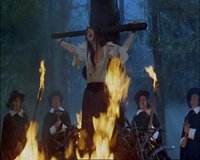 We see her tied to a stake and Gustav asks that God has mercy on her soul and then thrusts a burning torch into the surrounding kindle. As she burns, they pray. It is a dark beginning for a dark movie, one in which there are very few good characters, there are the evil ones, of course, but most are like Gustav Weil – tyrannical in their fanatical godliness. The beginning is very much based upon the evil that men do unto each other.
We see her tied to a stake and Gustav asks that God has mercy on her soul and then thrusts a burning torch into the surrounding kindle. As she burns, they pray. It is a dark beginning for a dark movie, one in which there are very few good characters, there are the evil ones, of course, but most are like Gustav Weil – tyrannical in their fanatical godliness. The beginning is very much based upon the evil that men do unto each other.
A coach rides through the countryside and stops for a cart which has lost a wheel, two of the passengers are very pretty twins, Maria and Frieda Gellhorn (Mary and Madeline Collinson, respectively). They spot Karnstein castle and Frieda wonders who lives there and is told, by a dour woman, Count Karnstein. They say they are new to the area, moved from Venice. In fact their parents have died and they are going to stay with their guardians, Uncle Gustav and Aunt Katy (Kathleen Byron). Just a quick note about the twins, they were actually playboys first playmate twins the year before this film. Neither are remarkable actresses, indeed they are dubbed through the film, but they certainly look pretty enough. To a degree their acting ability is unimportant as they are more a catalyst for the story of Gustav Weil who really is centre stage of this film.
Back at their new home Katy is worried about their dresses; in Karnstein (now the name of the village as well as the castle overlooking it) they would still be expected to wear black, even though two months have passed since their parents' deaths. 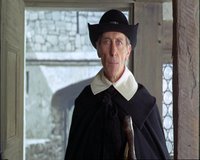 She sends them to change into something more sombre when Gustav returns and is incensed at their lack of respect. He quotes the fourth Commandment at them (honour thy father and mother). Gustav isn’t staying as he has a meeting of the Brotherhood, the puritanical group who burned the ‘witch’. We see their method of justice at the meeting, they still search for evil, two men have been killed both marked by the devil, and one says he knows of a woman who lives alone and refuses to marry. They ride to find her.
She sends them to change into something more sombre when Gustav returns and is incensed at their lack of respect. He quotes the fourth Commandment at them (honour thy father and mother). Gustav isn’t staying as he has a meeting of the Brotherhood, the puritanical group who burned the ‘witch’. We see their method of justice at the meeting, they still search for evil, two men have been killed both marked by the devil, and one says he knows of a woman who lives alone and refuses to marry. They ride to find her.
Meanwhile the two girls are in bed. Frieda is disgusted, it is only nine o’clock, and makes her feelings about her uncle very clear. She believes him to be a pervert who gets his thrills from doling out punishments. It is quickly clear that Maria is the good, dutiful twin and Frieda is the rebellious one.
The Brotherhood arrives at the hut, watched by Joachim (Roy Stewart). Gustav bursts into the hut but the woman, Gerta (Luan Peters), is not alone - Count Karnstein is with her. He mocks Weil, knowing that he is quite safe as he carries the protection of the Emperor. The mocking continues as Weil leaves and, angry, he aims a flintlock pistol at the Count. Joachim steps in the way but the Count laughs and says let him shoot, knowing that the threat of his royal connections protects him. Weil backs off and the Brotherhood ride, but on their journey they hear a scream and find a man, the colour drained from his face and puncture wounds in his neck. They ride on and see a girl innocently walking down the road; they ride her down, take her and burn her. It is interesting to note here that there was already a vampire on the prowl – one that is not dealt with, nor in fact seen, in the film.
In their home Gustav rants to Katy about the sins of the aristocracy, unaware that Frieda is listening from upstairs. When he shouts that the Count holds unspeakable, debauched gatherings at the castle, Frieda’s eyes noticeably widen. She goes to the window, from where the castle can be seen, and tells Maria she wishes to meet the Count.
There is actually a satanic rite ongoing in the castle, or at least a fake one arranged by Dietrich (Dennis Price) who is employed by the Count to find entertainment for him. The Count bores of the charade and kicks the Satanists out, followed by Dietrich, but keeps the peasant girl tied to the altar. Bored he intones a prayer to Satan and stabs the girl, her blood runs into a crack in the altar, which hides a coffin within, and the blood hits the shrouded corpse. 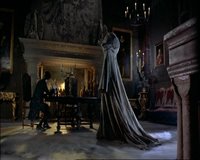 As the Count sits, still bored, the candles blow out as lightning rips the sky (watched in the village by Frieda). A hooded figure forms and floats towards the Count. It is a haunting and beautifully shot scene evoking the full richness of Hammer gothic imagery. He backs away and then realises she is Mircalla Karnstein. They kiss and he asks if he must give his life. She replies that it is his soul he must give, his body will remain undead. They love, the idea of what is going on being shown by some suggestive hand movements on a candle (quite an infamous scene and a little puerile after the richly evocative arrival of the Countess) and, afterwards, Mircalla takes him to a mirror. He is reflected but she is not. She bites him and they look to the mirror again and his reflection fades to nothing. This is the sum total of Mircalla/Carmilla’s involvement in the film.
As the Count sits, still bored, the candles blow out as lightning rips the sky (watched in the village by Frieda). A hooded figure forms and floats towards the Count. It is a haunting and beautifully shot scene evoking the full richness of Hammer gothic imagery. He backs away and then realises she is Mircalla Karnstein. They kiss and he asks if he must give his life. She replies that it is his soul he must give, his body will remain undead. They love, the idea of what is going on being shown by some suggestive hand movements on a candle (quite an infamous scene and a little puerile after the richly evocative arrival of the Countess) and, afterwards, Mircalla takes him to a mirror. He is reflected but she is not. She bites him and they look to the mirror again and his reflection fades to nothing. This is the sum total of Mircalla/Carmilla’s involvement in the film.
The next day the twins and Katy are in a horse and trap, they pause for a boar hunt (the boars being represented by movement in hay, as though in the underbrush, the cheapest effect in the movie) and Maria is obviously distressed by the hunt. They are taken to the school which is taught by Ingrid Hoffer (Isobel Black) and her brother Anton (David Warbreck), the choirmaster, who is on the boar hunt. When he returns he is obviously fascinated by Frieda and can tell them apart (he is the only one who can). Maria asks him about the history of Karnstein and, whilst they are talking, Frieda spots the coach of the Count entering the village (again, as in all the Carmilla cycle sunlight is of nothing to the vampires).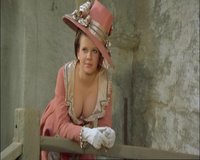 Frieda takes herself outside and puts her cleavage on full display for the Count. As they talk Gustav rides up and warns him away from his nieces. However, that night, Frieda sneaks out of the house, bullying her sister to remain silent, to meet the Count. She is picked up, literally, by Joachim and taken to a dinner party with the Count, Dietrich and Gerta. The Count taunts Dietrich first of all, who is worried about the girl he supplied for the Count (the sacrifice) as she is missing and then Gerta. He deems Gerta needs punishment and he and Frieda will do it.
Frieda takes herself outside and puts her cleavage on full display for the Count. As they talk Gustav rides up and warns him away from his nieces. However, that night, Frieda sneaks out of the house, bullying her sister to remain silent, to meet the Count. She is picked up, literally, by Joachim and taken to a dinner party with the Count, Dietrich and Gerta. The Count taunts Dietrich first of all, who is worried about the girl he supplied for the Count (the sacrifice) as she is missing and then Gerta. He deems Gerta needs punishment and he and Frieda will do it.
Gerta ends up chained in the dungeon and it is clear the Count wants Frieda to kill her. Before that, however, he reveals his vampiric nature to the twin. She fears he will kill her but he tells her it is a test and an interesting new aspect of Hammer vampire lore is introduced. If someone is bitten by a vampire and they are dedicated to Satan they will become undead, otherwise they will die. He bites Frieda (whilst in bed Maria feels the bite) and her reflection vanishes. He takes her to Gerta and unusually there is not a neck bite, Frieda aims for the breast. I say unusually, but this was a feature in The Vampire Lovers (1970), however this movie does not contain overt lesbian overtones as its predecessors did.
Immediately after this we see a witch burning and then cut to Anton who is disgusted by the atrocities the Brotherhood commit in the name of God. More so he is disgusted by his own cowardice at doing nothing. To distract him Ingrid tells him she has noticed that he is fascinated by Frieda and that he can seem to tell the two apart. Frieda, he says, has a fire and a mystery that Maria does not have.
It appears that some time has passed since Frieda was turned as reference is made, when Frieda sneaks back into her room, of her constant visits to the Count, whilst Frieda ensures Maria does not catch her lack of reflection in the mirror. Poor Maria has been taking the brunt of this. She pretended to be Frieda that night to allay her uncle’s suspicions and was beaten for not telling where Maria was and will be beaten again in the morning, as Maria, for sneaking off.
Weil visits Anton, who has written to the church Elders to complain about the actions of the Brotherhood. Gustav is now to investigate Anton. He notes the books on witchcraft and vampires, history Anton claims. They argue and Weil shouts that fire purifies. Anton says not, that with vampires (if they were to exist) only the stake or beheading kills them – we will hear more of this later. Anton is threatened by Weil, who also threatens his sister’s safety. In response Anton sends his sister to visit their aunt in a nearby village. There is an ‘improvement’ in the situation however; the Brotherhood will now hold a public trial before burning.
That night Frieda is sneaking  out again and Maria tries to stop her. In a brief moment of remorse (perhaps) Frieda says she cannot stay and seems to be about to say that she would attack her sister if she did, but then leaves. That night she kills Dietrich. The next day Weil bursts into the school with a body, proof of vampires for Anton who is outraged that a corpse is brought into the school. We expect it will be Dietrich but, instead, it is Ingrid. All the school seem shocked except Frieda who smiles.
out again and Maria tries to stop her. In a brief moment of remorse (perhaps) Frieda says she cannot stay and seems to be about to say that she would attack her sister if she did, but then leaves. That night she kills Dietrich. The next day Weil bursts into the school with a body, proof of vampires for Anton who is outraged that a corpse is brought into the school. We expect it will be Dietrich but, instead, it is Ingrid. All the school seem shocked except Frieda who smiles.
That night Freida attacks a Brotherhood member, attracting the attention of his fellows who come rushing to his screams. She rushes to her uncle asking to be saved as they were attacked by a vampire but Weil sees the blood on her lips (well it wasn’t really hard to spot). She claims that the blood came from the vampire, who tried to kiss her but Weil isn’t moved and holds out a cross. 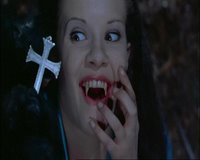 Frieda bears fangs and gives herself away as Weil cries “The Devil has sent me twins of evil!” The Brotherhood drags her to gaol. Back at home Weil removes his belt, he intends to beat Maria. Katy stands up to him, however. Interestingly there is a discourse where Weil says he wishes to beat the devil out of her and Katy wonders whether he beat the devil into Frieda. It is from here that Weil starts to question his actions and choices. Katy tells him that Maria is sleeping, she gave her a sleeping draught, with the holy cross clutched to her breast. Weil leaves for Frieda’s trial and Katy looks in on Maria. Her sleep is restless and she starts to talk, telling Frieda not to go to the Castle and not to go to the Count – Katy realises where the evil is and rushes to tell her husband.
Frieda bears fangs and gives herself away as Weil cries “The Devil has sent me twins of evil!” The Brotherhood drags her to gaol. Back at home Weil removes his belt, he intends to beat Maria. Katy stands up to him, however. Interestingly there is a discourse where Weil says he wishes to beat the devil out of her and Katy wonders whether he beat the devil into Frieda. It is from here that Weil starts to question his actions and choices. Katy tells him that Maria is sleeping, she gave her a sleeping draught, with the holy cross clutched to her breast. Weil leaves for Frieda’s trial and Katy looks in on Maria. Her sleep is restless and she starts to talk, telling Frieda not to go to the Castle and not to go to the Count – Katy realises where the evil is and rushes to tell her husband.
The Count steps into the room, once Katy has left. He approaches Maria but the cross holds him back. Eventually she drops the cross and the Count abducts her. With Joachim, he takes her to the gaol where, after hypnotising the gaoler, they do the old switcheroo sending Frieda to the house and leaving Maria to the justice of the Brotherhood. Whilst this is occurring the trial is over and done with rather quickly, Frieda must burn though Weil seems reticent. Anton rushes in and is sent to Maria.
Of course, once Anton arrives, it is Frieda in the house. Katy is away looking for Weil and so Frieda comes on to him. His ability to tell the two apart fails him as she bewitches him with her eyes but a glance in the mirror shows she has no reflection. They struggle as she tries to bite him but he grabs the cross from the floor and holds her off. He throws the cross onto her half naked form and, whilst pulling it from her breast, she burns her hand giving him chance to escape to save Maria. Maria’s burning has been delayed by interference from Katy and so Anton has time to get there and, with difficulty, persuades them to hold the cross to Maria who does not flinch. Katy realises Frieda will be at the castle.
The Brotherhood does not wish to attack the aristocracy but Anton rallies them and also persuades them that they must behead or use the stake. Weil asks him if such methods will free the soul of the vampire and Anton confirms it will if there is an ounce of goodness left. The mob marches on the castle.
The Count is dismissive, though Frieda is scared. He explains that fire will make their bodies melt away without pain and their souls will find new bodies and new victims – I liked that bit. However Joachim mimes (as he is mute) that they have stakes and axes. He is left to hold the mob off as they escape through the tunnels. There is a fairly gory fight, Joachim burning one man’s eye out and cleaving the skull of another but is soon overrun. However the Count has reached the escape door. He sends Frieda out first who is grabbed by Weil, lying in wait, and beheaded. The Count slams and locks the door as Weil orders his nieces’ body sent to the chapel.  Unfortunately Maria feels the beheading and runs to find her sister and ends up caught by the Count who heads back into the castle. He threatens to throw her from the balcony but is attacked by Weil. The Count mocks his adversary and Weil misses, getting an axe in the back for his effort and his body thrown from the balcony. Anton, who we must remember is a wild boar hunter, throws a spear and gets the count right in the heart. He goes up to Maria, as the Count decays, and they look down at her uncle’s body.
Unfortunately Maria feels the beheading and runs to find her sister and ends up caught by the Count who heads back into the castle. He threatens to throw her from the balcony but is attacked by Weil. The Count mocks his adversary and Weil misses, getting an axe in the back for his effort and his body thrown from the balcony. Anton, who we must remember is a wild boar hunter, throws a spear and gets the count right in the heart. He goes up to Maria, as the Count decays, and they look down at her uncle’s body.
It is a dark ending to a dark film and Cushing steals the show. There is no happy ending; Maria has lost her sister and her uncle. Her uncle’s repentance is cut short by the Count and we can only hope that Frieda’s unwillingness to attack her sister earlier in the film means that her soul is set free, but that was probably superseded by her swapping places and leaving her sister to burn.
All the performances are good, bar the Collinson’s, whose performances are functional enough, despite a few odd expressions that don’t seem to fit, but generally do look good. The Count makes for an unusual portrayal, Thomas’ performance capturing aristocratic arrogance and corruption making him less the imposing figure of Lee’s Dracula and more the corrupt Byronic rake. If Thomas failed at all it was only because his performance could never match that of Cushing.
The musical score is more dynamic than many Hammers and really fits the piece well. We are, however, left with some mysteries. Where did Mircalla go? Who was the earlier vampire? They are unimportant however as our focus is on Gustav Weil and his tyranny and later realisation, it is fitting that as the credits opened Cushing was given top billing. We become absorbed with wondering whether we should root for the vampires or the Brotherhood, they are both evil in their own way. The vampire’s evil is both decadent (the Count) and born of rebellion and anger (Frieda), whilst the Brotherhood’s evil is born of ignorance, fanaticism and self-righteousness. Even the ‘good’ characters are not immune; Anton fights his own, self-recognised, cowardice (‘the only thing necessary for the triumph of evil is for good men to do nothing.’ As Edmund Burke said.) Much the same could be said of Katy and her refusal to stand up for the Twins against her abusive husband and 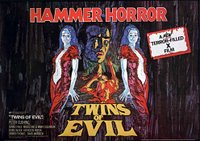 Maria as a character is flawed, the victim and the bullied, pitied but not strong, blinded by her loyalty to her sister. Do not get me wrong, these identified flaws are not meant to demean bullied people, bullying is wrong and the courage needed to stand up to a bully and break from the cycle immense, but not one character meets the standard movie template of a heroic role model. The film brings out the weakness inherent in humanity and holds them up for us to see.
Maria as a character is flawed, the victim and the bullied, pitied but not strong, blinded by her loyalty to her sister. Do not get me wrong, these identified flaws are not meant to demean bullied people, bullying is wrong and the courage needed to stand up to a bully and break from the cycle immense, but not one character meets the standard movie template of a heroic role model. The film brings out the weakness inherent in humanity and holds them up for us to see.
The sets are excellent, the castle and graveyard are wonderfully gothic and the village looks unusually squalid, a touch of realism all too often missed in other Hammers. The village would be reused in the 1972 Hammer flick “Vampire Circus”.
The story is well rounded and occasional red herrings are used well. The revealing of Ingrid’s corpse comes as a shock to the audience and, whilst we know who the vampires are we wait to see if the characters can work it out rather than getting annoyed because the film makers are pretending we don’t know.
This is a great Hammer movie and thoroughly deserves 8 out of 10.
The imdb page is here.
Tuesday, June 13, 2006
Twins of Evil - review
Subscribe to:
Post Comments (Atom)
















11 comments:
Sounds great. I've not seen the last two films you've reviewed (Lust for a Vampire and this one), but now I feel I need to make at least an effort to see Twins of Evil.
I've always heard Twins of Evil isn't one of the better Hammer productions, and so I never really tried to seek it out. But we seem to have similar tastes when it comes to Hammer vampire flicks, so I think I'll make a more concentrated effort to find it.
Thanks for the review!
Mark, I personally think the film is great and I would recommend you giving it a go...
that said, Lust for a Vampire... given your wife's feelings about the vampire lovers... perhaps not the best one to go for, heh... it is very much an exploitation flick and with the story as it is there is very little excuse... except for the "but it has vampires, and it's a Hammer"
Just four more Hammer movies to go...
This is a great writeup. I saw the film and have a little write up of my own.
miceland TOE
Cheers Mice,
Nice write up and some great screenshots
I'm glad I was able to see it, it is not available in the US.
Not only has it become one of may favorite Hammer films (Brides is still my fav). But I also got tunred onto a true fan of the vampires, keep up the good work.
This is my favourite Hammer film save for Scars of Dracula. They don't make films like these anymore and for some reason vampire films of this ilk are done quite well when filmed in a Germanic setting. I liked back in the old days when the origins of vampires were simple (read: servants of satan) same with Nosferatu etc - not Judas Iscariot or from Ancient Egypt possessed by the spirt Amel ala Anne Rice or the other countless origins.
The sets and costumes of these movies are excellent, and using a British cast for vampire films is always bounds ahead of other productions. There is something about the technocolour matte of the film print back then too along with the fake bright, red blood that make these films great. Vampire Circus is another hammer film that I think is similar to this.
Also, I think part of the reason the film is so dark and disturbing is because just before filming Peter Cushing's wife passed away and he still agreed to do the film, and I think his despair carried onto his performance as this is his most dark performance in a Hammer film I imagine.
The vmpire being the servnt of Satan makes things simple and makes the crucifix aversion meaningful. However, I like the variety that has come into the genre. Be it egyptian demon possession or the betrayal of Christ, be it alien entity or spirit possession. Be it genetic mutation or evolution. The vampire has become one of the most maleable archetypes and in this is the strength.
This is certainly up there amongst my favourites, as well as Captain Kronos, Horror of dracula etc...
Hello Andy, long time I know but I've had LONG PC problems.
If you didn't know Shaun Hutson has novelized this classic, I've ordered my copy from Amazon
http://www.amazon.co.uk/gp/product/0099556197/sr=8-5/qid=1330772200/ref=olp_product_details?ie=UTF8&me=&qid=1330772200&sr=8-5&seller=
Hi Ollie, sorry to hear about your PC problems - there is nothing worse.
I am aware of the Hutson novelisation, indeed you can read my thoughts on it here.
Once you've read it, let me know if you agree or disagree with my assessment :)
Post a Comment